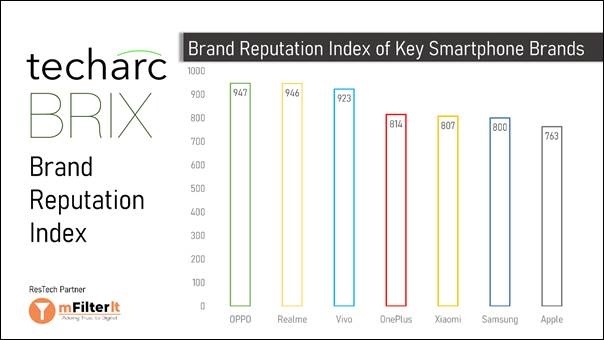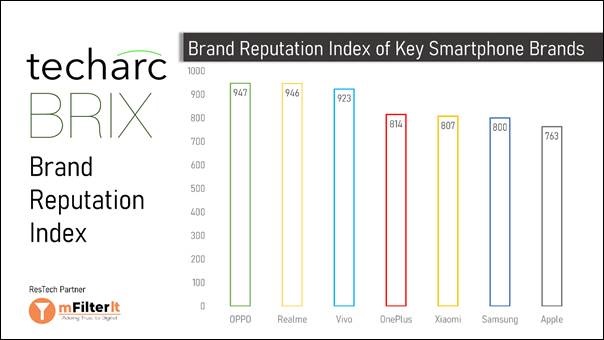
 Apple reports maximum brand reputation issues while OPPO tops the Brand Reputation Index among key smartphone OEMs in India.
Apple reports maximum brand reputation issues while OPPO tops the Brand Reputation Index among key smartphone OEMs in India.
In its first Brand Reputation Index (BRIX) measuring the risk score of potential frauds and scams that can be done leveraging a Brand’s equity, Techarc in association with mFilterIt, today said that smartphone brands having strong consumer pull report most of the reputation issues caused by infringement of brands in the digital space.
The three main techniques of brand infringement identified are: –
Fake Gratification: Instances where scammers infringe any brand’s identity by offering fake coupons, rewards, schemes, and discounts. This is the easiest trap for consumers who are searching for best deals when they decide about buying a smartphone of their interest. Since, covid-19 pandemic started, fake gratification has also surfaced in cases like offering dealerships and other similar business partnership offerings by the brands.
Fake Presence: Social-media is the easiest way for brands to let potential buyers discover them and engage throughout the customer lifecycle starting for presales to after sales engagement. Fraudsters create fake profiles on popular social networking applications and allure audiences which want to genuinely engage with the brand. In many instances, fake gratifications are routed through such accounts to entice people looking for smartphones deals. Social media has also become a key medium to run fake job rackets on behalf of leading smartphone brands. People looking for jobs take them as genuine as it could be coming from authorised agencies acting on behalf of their principals.
Fake Representation: This is the severest level of infringement where scammers create a fake website, app or a marketplace. Using typosquatting techniques, fraudsters create very similar websites, apps and marketplaces and then direct users on such sites to engage which could be used for data theft to financial frauds.
Commenting on the BRIX findings, Faisal Kawoosa, Founder & Chief Analyst, Techarc said, “Brand Safety is Business Safety! As digital becomes mainstream and brands increase their D2C engagements, they need to proactively police the digital space to hunt for any infringement cases.”
Elaborating on how this can be achieved, Faisal added, “The first thing brands need to do is to come out of denial mode and create a common synergy between marketing, ecommerce, IT and digital teams. For instance, CISO primarily is mandated to secure the owned digital assets of an organisation. Now, they should also be looking at how the brand is secured wherever it gets referenced, even on news portals.”
Implications for brands
A lower BRIX score means that the brand is prone to higher risk of being hijacked for scams and frauds. Some of the key threats that could result due to lower BRIX score are: –
Data theft as audiences filling up forms and sharing details would consider these digital assets to be from the brand or their authorised agencies.
Account Takeover (ATO) fraud where an existing subscription or user account is accessed to result in financial fraud and/or siphon off the loyalty points accrued. As the brands usher into strong community building initiatives and use of NFT (Non-Fungible Token) based reward systems, this can become a high-risk zone.
Selling of counterfeit products. Many such fraudsters roll out jaw-dropping offers for purchase smartphones, which are even lower than the price at which a brand is selling its smartphone on its own D2C platform. However, one of the reasons of selling such discounted products is either a counterfeit product or stolen inventory.
Financial frauds in terms of asking for a small token amount to confirm the order and balance COD. In such cases, fraudsters ask for 10-25% of a heavily discounted price of a smartphone as the confirmation money and go into hiding after scamming a few hundred users.
Fake apps and fake websites are also potential cyberthreats as they install malware and drop cookies which then steal data of the users who install such apps or click on such links.
Bogus business partnership / association offers that include offering dealership, service centres, retail outlets, etc., on behalf of reputed brands.
Fake job postings especially in regional offices / field areas which is again done for financial fraud or data stealing.
Adding further, Saloni Jain, Lead Analyst for DigiTech focus area at Techarc said, “In various surveys we have found that 70-80% of the users who originate their purchase from online sources do it looking for best deals and offers. This becomes a great incentive for fraudsters to run such ‘Ponzi’ schemes infringing a brand’s identity.”
“The only way for brands to stop this is proactive monitoring and taking up such issues with platforms like social networking apps, domain registries, etc.,” said Saloni.
About the study
Seven popular smartphone brands – Apple, OPPO, OnePlus, Realme, Samsung, Vivo and Xiaomi (Redmi and Mi) were monitored across digital ecosystem for 15 days and any infringement case was captured leveraging mFilterIt’s Brand Infringement reporting solution. The instances were then categorised and measured for BRIX score as per the defined methodology.
